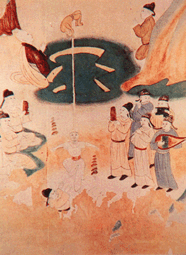
Acrobatics is a performance art that combines physical strength and skill. The Encyclopedia Britannica describes acrobatics as "the specialized and ancient art of jumping, tumbling, and balancing, often using apparatus such as poles, unicycles, balls, barrels, tightropes, trampolines, and flying trapezes."
Chinese acrobatics reached a high level of sophistication as early as the
Warring States Period(475-221BC) during the third century BC, with acrobats proficient at juggling seven daggers while manipulating 3-meter stilts.
Acrobatic performances are vividly depicted in brick paintings and stone engravings dating back to the
Han Dynasty(206BC-220AD). Various works depict acrobats performing hand tricks such as juggling with swords, balls, and bottles, as well as stunts using long poles, barrels, drum carts, and galloping horses.
A brick painting unearthed from a Han tomb in Pengxian County of Southwest China's
Sichuan Provinceportrays three acrobats -- one performing handstands atop 12 stacked tables; another dancing on drums; and a third juggling balls. A point well worth mentioning is that modern acrobatic performances continue to feature high-altitude handstands.
A stone engraved with "Bai xi tu" that was discovered in a Han tomb in Yinan County of East China's
Shandong Province, provides a vivid picture of ancient Chinese acrobats performing in a circus. The work entitled "Variety Show" was found in a tomb in Beizhai Village some eight kilometers west of Yinan County. The work can be divided into four parts viewed from left to right.
Part one features ball and dagger juggling, as well as a man balancing a cross on his forehead while three boys perform stunts such as tumbling and hanging upside down on the cross. The performer possessed great skill in simultaneously balancing the cross and avoiding seven plates placed at his feet.
Part two shows an orchestra of 15 musicians playing
chime stones, bells, jian-drums, zithers (a kind of stringed instrument), xun (an egg-shaped wind instrument), and panpipes.
Part three depicts "Tightrope Walking Over a Mountain of Knives" and "Yulongmanyan Dance." The former shows an acrobat performing handstands on a tightrope above a series of upright knives while a performer at one end of the rope appears to be spinning meteor-like bulbs and a performer at the opposite end, juggling tridents (three-pronged spears). The latter is a majestic demonstration of acrobatic performances featuring imitations of laop fish (define what "laop" means), dragons, and birds.
